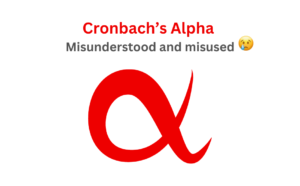
If you are using a measurement scale in your dissertation, chances are that you have written about Cronbach’s alpha, or Coefficient alpha, in a section on reliability in your proposal or dissertation. Unfortunately, most students misapply the concept.
I believe Cronbach’s alpha is one of the most misunderstood concepts in research involving measurement. There are several reasons why.
SO, WHAT IS CRONBACH’S ALPHA?
Cronbach’s alpha measures the internal consistency of a measurement instrument or a part of it. It measures how closely related the items are. It is the most reported type of reliability.
If a measurement instrument’s internal consistency is low, then there is heterogeneity, or lack of consistency, among its items, making it uncertain what the total score measures and implying the presence of random error in its scores.
WHY IS ALPHA MISUNDERSTOOD?
First, Cronbach’s alpha is mistaken as a measure of the reliability of the research. However, it refers to the reliability of measurement, not the reliability of the overall research or study. In many proposals and quantitative dissertation templates, there are separate sections on the reliability of the measurement scale and the reliability of the research. Alpha belongs under the reliability of the measurement scale.
Second, some students doing qualitative interviews say they will calculate alpha for the questions of their qualitative interview instrument. Alpha can only be computed for a quantitative measurement instrument.
Third, internal consistency does not imply unidimensionality. A high alpha value does not mean that all the items in an instrument measure the same thing. Instead, it means that every item in the instrument measures something similar to some of the other items, but the instrument may still be multi-dimensional.
Fourth, unless the measurement instrument is unidimensional (check this via factor analysis or similar), the total score may not be interpretable, even if alpha is high.
Fifth, do not assume that an instrument with an alpha value of .7 indicates a sufficient reliability or internal consistency measure. This value is arbitrary and increases with the number of items in the instrument. A long measurement instrument may have a high alpha value, but its internal consistency may still be poor.
Sixth, a very high alpha value is not necessarily good, as it may imply redundant items in the instrument that should be dropped. Alpha values greater than .9 may suggest you have unnecessary items on your scale.
Seventh, you cannot assume published reliability values will apply to your sample and test situation. It is important to quote your alpha value and those published.
Finally, it is inappropriate to calculate the alpha value for a knowledge test with different facets or dimensions. You need to calculate alpha per facet.
It is good to check that you have avoided falling into these traps. I hope these checks help you!